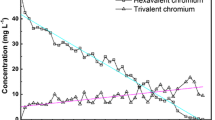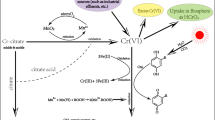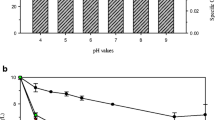Summary
Cr(VI)-reducing bacteria are widespread and Cr(VI) reduction occurs under both aerobic and anaerobic conditions. Under aerobic conditions, both NADH and endogenous cell reserves may serve as the electron donor for Cr(VI) reduction. Under anaerobic conditions, electron transport systems containing cytochromes appear to be involved in Cr(VI) reduction. High cell densities are necessary to obtain a significant rate of Cr(VI) reduction. Cr(VI) reduction by bacteria may be inhibited by Cr(VI), oxygen, heavy metals, and phenolic compounds. The optimum pH and temperature observed for Cr(VI) reduction generally coincide with the optimal growth conditions of cells. The optimum redox potential for Cr(VI) reduction has not yet been established.
Similar content being viewed by others
References
Bopp, L.H. and H.L. Ehrlich. 1988. Chromate resistance and reduction inPseudomonas fluorescens strain LB300. Arch. Microbiol. 150: 426–431.
Cervantes, C. and S. Silver. 1992. Plasmid chromate resistance and chromate reduction. Plasmid 27: 65–71.
Enterline, P.E. 1974. Respiratory cancer among chromate workers. J. Occup. Med. 16: 523–526.
Gvozdyak, P.I., N.F. Mogilevich, A.F. Rylskii and N.I. Grishchenko. 1986. Reduction of hexavalent chromium by collection strains of bacteria. Mikrobiologiya 55: 962–965.
Horitsu, H., S. Futo, Y. Miyazawa, S. Ogai and K. Kawai. 1987. Enzymatic reduction of hexavalent chromium by hexavalent chromium tolerantPseudomonas ambigua G-1. Agric. Biol. Chem. 51: 2417–2420.
Ingledew, W.J. and R.K. Poole. 1984. The respiratory chains ofEscherichia coli. Microbiol. Rev. 24: 1143–1150.
Ishibashi, Y., M. Beck, C. Cervantes and S. Silver. 1989. Chromium reduction inPseudomonas putida. Abst. 89th Annu. Meeting, Am. Soc. Microbiol. 89: 361.
Ishibashi, Y., C. Cervantes and S. Silver. 1990. Chromium reduction inPseudomonas putida. Appl. Environ. Microbiol. 56: 2268–2270.
Komori, K., A. Rivas, K. Toda and H. Ohtake. 1989. Biological removal of toxic chromium using anEnterobacter cloacae strain that reduces chromate under anaerobic conditions. Biotechnol. Bioeng. 35: 951–954.
Komori, K., P.C. Wang, K. Toda and H. Ohtake. 1989. Factors affecting chromate reduction inEnterobacter cloacae strain HO1. Appl. Microbiol. Biotechnol. 31: 567–570.
Kvasnikov, E.I., T.M. Klyushnikova, T.P. Kasatkina, V.V. Stepanyuk and S.L. Kuberskaya. 1988. Chromium-reducing bacteria in nature and in industrial sewage. Mikrobiologiya 57: 680–685.
Kvasnikov, E.I., V.V. Stepanyuk, T.M. Klyushnikova, N.S. Serpokrylov, G.A. Simonova, T.P. Kasatkina and L.P. Panchenko. 1985. A new chromium-reducing, gram-variable bacterium with mixed type of flagellation. Mikrobiologiya 54: 83–88.
Lebedeva, E.V. and N.N. Lyalikova. 1979. Reduction of crocoite byPseudomonas chromatophila sp. nov. Mikrobiologiya 48: 517–522.
Lehninger, A.L. 1982. Principles of Biochemistry. 4th edn, pp. 467–505, Worth Publishers, New York.
Llovera, S., R. Bonet, M. Simon-Pujol and F. Congregado. 1993. Chromate reduction by resting cells ofAgrobacterium radiobacter EPS-916. Appl. Environ. Microbiol. 59: 3516–3518.
Lovley, D.R. 1993. Dissimilatory metal reduction. Ann. Rev. Microbiol. 47: 263–290.
Lovley, D.R. and E.J.P. Phillips. 1994. Reduction of chromate byDesulfovibrio vulgaris and itsc 3 cytochrome. Appl. Environ. Microbiol. 60: 726–728.
Ohtake, H., E. Fujii and T. Toda. 1990. Reduction of toxic chromate in an industrial effluent by use of a chromate-reducing strain ofEnterobacter cloacae. Environ. Technol. 11: 663–668.
Ohtake, H., E. Fujii and T. Toda. 1990. A survey of effective electron donors for reduction of toxic hexavalent chromate byEnterobacter cloacae (strain HO1). J. Gen. Appl. Microbiol. 36: 203–208.
Patterson, J.W. 1985. Industrial Wastewater Treatment Technology. Butterworth Publishers, Stoneham, MA.
Roe, F.J.C. and R.L. Carter. 1969. Chromium carcinogenesis: calcium chromate as a potent carcinogen from the subcutaneous tissues of the rat. Brit. J. Cancer 23: 172–176.
Romanenko, V.I. and V.N. Korenkov, 1977. A pure culture of bacteria utilizing chromates and dichromates as hydrogen acceptors in growth under anaerobic conditions. Mikrobiologiya 46: 414–417.
Shen, H. and Y.T. Wang. 1993. Characterization of enzymatic reduction of hexavalent chromium byEscherichia coli ATCC 33456. Appl. Environ. Microbial. 59: 3771–3777.
Shen, H. and Y.T. Wang. 1994. Modeling hexavalent chromium reduction inEscherichia coli 33456. Biotechnol. Bioeng. 43: 293–300.
Shen, H. and Y.T. Wang. 1994. Biological reduction of chromium byE. coli. J. Environ. Eng. 120: 560–572.
Shen, H. and Y.T. Wang. Hexavalent chromium removal in a two-stage bioreactor system. J. Environ. Eng. (accepted for publication).
Suzuki, T., N. Miyata, H. Horitsu, K. Kawai, K. Takamizawa, Y. Tai and M. Okazaki. 1992. NAD(P)H-dependent chromium(VI) reductase ofPseudomonas ambigua G-1: a Cr(VI) intermediate is formed during the reduction of Cr(VI) to Cr(III). J. Bacteriol. 174: 5340–5345.
Towhill, L.E., C.R. Shriner, J.S. Drury, A.S. Hammons and J.W. Holleman. 1978. Reviews of the environmental effects of pollutants. III. Chromium. EPA 600/1-78-023, US EPA, Washington, DC.
Wang, P.C., T. Mori, K. Komori, M. Sasatsu, K. Toda and H. Ohtake. 1989. Isolation and characterization of anEnterobacter cloacae strain that reduces hexavalent chromium under anaerobic conditions. Appl. Environ. Microbiol. 55: 1665–1669.
Wang, P.C., K. Toda, H. Ohtake, I. Kusaka and I Yabe. 1991. Membrane-bound respiratory system ofEnterobacter cloacae strain HO1 grown anaerobically with chromate. FEMS Microbiol. Lett. 78: 11–16.
Wang, Y.T. and C. Xiao. Effect of environmental factors on biological reduction of chromium. Submitted to publication in Water Res.
Wang, Y.T. and H. Shen. 1993. Biological reduction of chromium with simultaneous degradation of aromatic pollutants. Proceedings of the Water Environment Federation 66th Annual Conference and Exposition. 1: 385–394. Anaheim, CA, Oct. 3–7, 1993.
Yamamoto, K., J. Kato, T. Yano and H. Ohtake. 1993. Kinetics and modeling of hexavalent chromium inEnterobacter cloacae. Biotechnol. Bioeng. 41: 129–133.
Author information
Authors and Affiliations
Rights and permissions
About this article
Cite this article
Wang, YT., Shen, H. Bacterial reduction of hexavalent chromium. Journal of Industrial Microbiology 14, 159–163 (1995). https://doi.org/10.1007/BF01569898
Received:
Accepted:
Issue Date:
DOI: https://doi.org/10.1007/BF01569898




